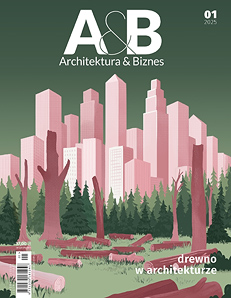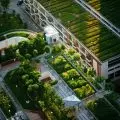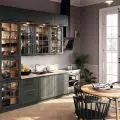This year's competition focused on the transformation and revitalization of a plot of land near the Viikki Research Farm and Veterinary Teaching Hospital, which are part of the University of Helsinki. The students were tasked with designing living spaces that fit harmoniously into their surroundings, with an emphasis on temporary housing for students and researchers and permanent units for residents. The most difficult part of the task was to integrate the new buildings with existing structures, surrounding greenery and educational and research infrastructure to create a coherent and functional urban space. Participants had to complete several tasks:
-
Design a new high-rise building that could serve as temporary or permanent housing.
-
Adopt an existing office building into stables for visiting scientists or students.
-
Connect the buildings with an outdoor green space.
-
Embrace the concept of sustainability, including circularity, embedded carbon footprint and energy efficiency, to ensure low environmental impact.
At Saint-Gobain, we are convinced that architecture together with construction can provide a strategic response to the key challenges posed by climate change, resource scarcity and urbanization. Like the construction industry, architects are at the forefront of the transformation to create sustainable places to live, to ensure its high quality of life and resource-efficient building solutions that respect the environment. They can make a real difference in a world where 7 out of 10 people will live in cities in 2050, and 80% of existing buildings will still be in use. The jury and I were happy to meet future architects so deeply committed to creating designs that have a better impact on people and a smaller carbon footprint affecting the planet," said Benoit Bazin, CEO of the Saint-Gobain Glass Group.
international jury
The international finals were preceded by local preselections, in which Aleksandra Tądel and Magdalena Strauchmann won First Prize. The chapter of the 19th. Edition of the competition sat: Alicja Kuczera (CEO, Polish Green Building Council, Chair of the GBC CEO Network, World Green Building Council), Tuomas Hakala (Head of Unit, Helsinki City Planning Department), Jaana Ihalainen (CEO, Helsinki University Properties Ltd), Rainer Mahlamäki (Founder, Lahdelma & Mahlamäki Architects), Francis Rambert (Head of Architectural Creation Department, Cite de l'architecture et du patrimoine), Carl Bäckstrand (Vice-President, Architects Council of Europe, Deputy CEO, White Arkitekter), Pascal Eveillard (Director of Sustainable Construction, Saint-Gobain) and Karel Sedláček (Building Science Marketing Manager, Saint-Gobain).
The composition of the jury was chosen to reflect diversity and a deep understanding of sustainability in architecture. Members came from a variety of professional and geographic backgrounds, which allowed for a comprehensive evaluation of projects. The professionals combined local knowledge of Helsinki's urban context, extensive academic experience, a critical view of architecture and a working knowledge of sustainable building practices. The diverse backgrounds allowed each aspect of the submitted projects to be discussed in detail, ensuring that participants received a fair and comprehensive evaluation. The jury is seeing an increasing level of competition entries, with one of the most important elements of evaluation becoming the analysis of a building's environmental impact throughout its life cycle. At the same time, the designs must meet functional and usability requirements, which poses an additional challenge for the contestants.
Visualization of the "Rurban Habitat" project.
© Aleksandra Tądel and Magdalena Strauchmann
"Rurban Habitat" project
In the international final, the winner was the project "SIENI PARK" by a team from Portugal. The second place went to the team from Poland with the project "Rurban Habitat " - Aleksandra Tądel and Magdalena Strauchmann, representatives of the Faculty of Architecture at the Wrocław University of Technology developed it under the supervision of Dr. Elżbieta Komarzyńska-Świeściak and Dr. Marek Lamber. The third place, on the other hand, went to representatives of South Korea for the project "From Boundary To Gateway". The special Teacher Prize, which has been in effect since this year and is awarded by project supervisors, went to a student from Malaysia for her project "Viikki - The Edu-Buoyancity." In turn, the well-known Student Prize, which is decided by all participating teams, went to representatives from Lebanon for the project "Eco-Habitat: Greenhouse Dorms and Urban micro climate".
"Rurban Habitat" presents a vision of circular architecture in a semi-urban part of Helsinki. Using a "explore, reduce, reuse, produce and integrate" approach , the project respects the existing context and uses local and passive solutions. The modular design of the core houses promotes adaptability, prefabrication and green energy production. Allocentric design enabled an inclusive environment for all, enriched with innovative research and creative space. The project was distinguished by a strong commitment to sustainability. Carefully considered solutions, preservation of the essence of the Viikki area, and numerous initiatives supporting biodiversity and protection of green spaces earned it the second prize. The jury particularly appreciated the harmonious combination of old and new elements and the emphasis on circular solutions.
Visualization of the "Rurban Habitat" project.
© Aleksandra Tądel and Magdalena Strauchmann





















